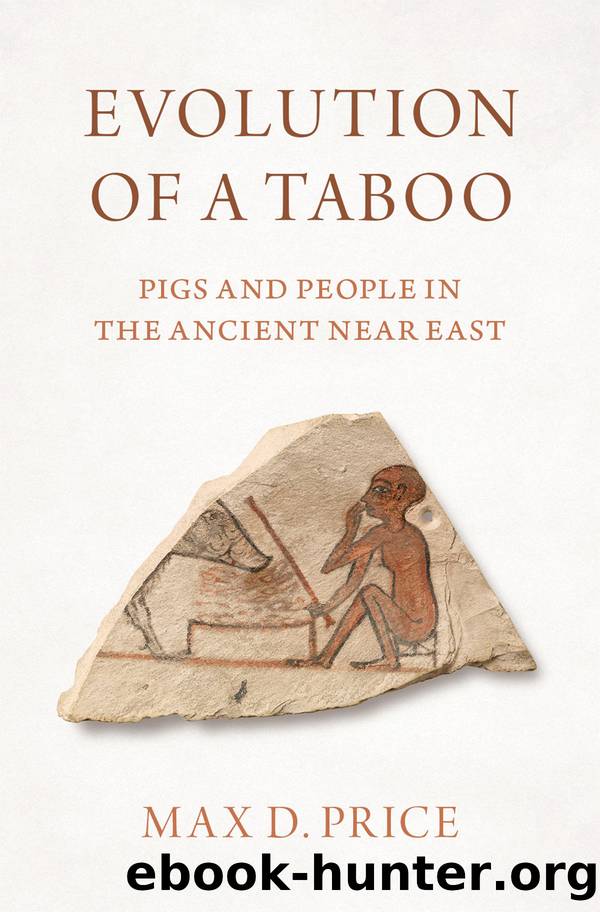Evolution of a Taboo by Max D. Price;

Author:Max D. Price;
Language: eng
Format: epub
Publisher: OUP Premium
Published: 2020-03-15T00:00:00+00:00
Unholy of Unholies: Pigs and the Clash of Cultures
The conflicts between Jewish and Greco-Roman cultures often drew upon, and occasionally centered around, their divergent attitudes toward pigs and pork. In the context of imperialism and Jewish nationalism, pig hatred and Jewish identity became caught in a positive feedback loop driven, on the one hand, by the Greek and especially Roman fixation on Jewsâ aversion to swine and, on the other, by many Jewsâ distrust of Greek and Roman culture. Each perceived the other as an existential threat. In the process, the pork taboo was elevated to a position of prominence in the Jewish dietary laws.
The Greek and Roman love of pigs and pork expanded into the Near East in the Classical period. The Levant, including Judea, was no exception. Zooarchaeological data indicate an uptick in pig husbandry during the 4thâ2nd centuries BC, with pigs comprising as much as 15â20 percent of the recovered bones of domestic livestock at some sites compared with the 1 percent or less typical of the Persian period (see Table A.5 in the appendix).83 Under Roman and Byzantine rule, pig husbandry expanded even further, especially in regions like the Galilee and northern coastal region, where the temperate climate encouraged swine production.84 For example, at 58 percent, pigs dominated the livestock bone assemblage at Caesarea.85 By the Byzantine period in what is now northern Israel, 10â50 percent of the domestic mammals slaughtered in the majority of cities were pigs.86
This increase in pigs represented a radical break with tradition. In aggregate, people inhabiting the Levant raised pigs in quantities not seen since the 4th millennium BC. However, there was significant variation. Settlements where Jewish populations are historically attested had much lower proportions of pig remains (less than 5 percent and often less than 2 percent) throughout the Hellenistic and Roman period.87 Similarly, relative abundances of pigs are much higher at sites with archaeological evidence of Hellenistic material culture than at sites with mikvah baths and other elements of Jewish material culture.88
It is simplistic to assume that the people who ate pork necessarily identified themselvesâand were identified by othersâas Greek, Roman, or otherwise non-Jewish. Nor can we assume that sites without pork were necessarily inhabited exclusively by Jews.89 For one thing, this assumption ignores the so-called Hellenized Jews, those who had adopted elements of Greco-Roman culture and incorporated them into local Levantine customs. Most, perhaps all, Jews in the Classical period had adopted some elements of Hellenic culture.90 Some Jews, while still firmly grasping their self-perception as Jews, must have succumbed to curiosity and tried pork, that meat held in such high esteem by the rest of the Hellenistic world. There is, in fact, scattered textual evidence for this rejection of traditionânamely Jews who raised pigs.91 They include the Talmudic legal discussion of damages done by pigs (e.g., Bava Kama 17b) and the story of the swineherd and his pigs in the exorcism of the Gerasene demoniac (e.g., Matthew 8:28â34). But perhaps most convincing are the bones themselves. While
Download
This site does not store any files on its server. We only index and link to content provided by other sites. Please contact the content providers to delete copyright contents if any and email us, we'll remove relevant links or contents immediately.
Sapiens: A Brief History of Humankind by Yuval Noah Harari(14320)
Sapiens by Yuval Noah Harari(5322)
Pale Blue Dot by Carl Sagan(4953)
Homo Deus: A Brief History of Tomorrow by Yuval Noah Harari(4871)
Livewired by David Eagleman(3729)
Origin Story: A Big History of Everything by David Christian(3666)
Brief Answers to the Big Questions by Stephen Hawking(3393)
Inferior by Angela Saini(3293)
Origin Story by David Christian(3170)
Signature in the Cell: DNA and the Evidence for Intelligent Design by Stephen C. Meyer(3098)
The Gene: An Intimate History by Siddhartha Mukherjee(3074)
The Evolution of Beauty by Richard O. Prum(2963)
Aliens by Jim Al-Khalili(2803)
How The Mind Works by Steven Pinker(2777)
A Short History of Nearly Everything by Bryson Bill(2659)
Sex at Dawn: The Prehistoric Origins of Modern Sexuality by Ryan Christopher(2500)
From Bacteria to Bach and Back by Daniel C. Dennett(2462)
Endless Forms Most Beautiful by Sean B. Carroll(2442)
Who We Are and How We Got Here by David Reich(2417)
